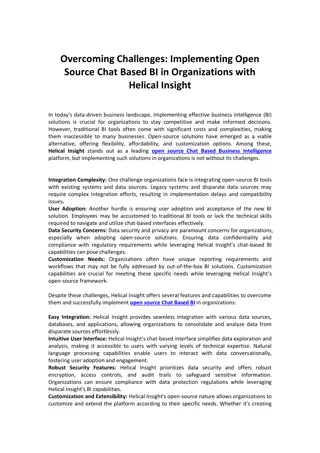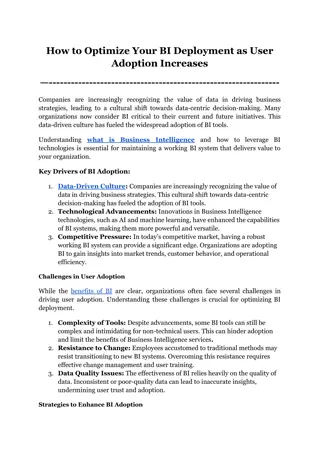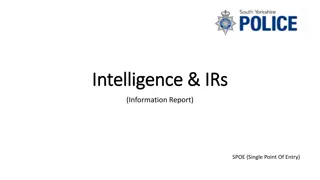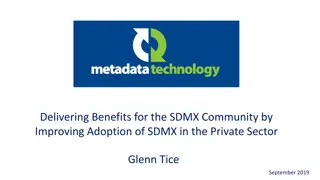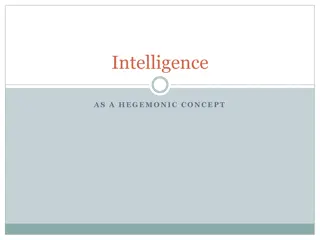Factors Influencing Business Intelligence Adoption in Public Sector Organizations
Public sector organizations are increasingly investing in Business Intelligence Solutions (BIS) to leverage data for decision-making. This study by Modiketse Tshehla explores the factors affecting BIS adoption, incorporating concepts like assimilation, adoption, diffusion, and infusion. Through research methodology including interpretivism and case studies, the study investigates the Technology-Organisation-Environment framework to understand the impact on BIS adoption. Key findings highlight the importance of factors like decision enhancement, expected benefits, and organizational acceptance in the adoption process.
Download Presentation

Please find below an Image/Link to download the presentation.
The content on the website is provided AS IS for your information and personal use only. It may not be sold, licensed, or shared on other websites without obtaining consent from the author. Download presentation by click this link. If you encounter any issues during the download, it is possible that the publisher has removed the file from their server.
E N D
Presentation Transcript
Factors affecting the adoption of business intelligence solutions in a public sector organisation Modiketse Tshehla The National School of Government 2024 March 05
Outline Concepts Introduction Research problem Methodology Framework Sampling Key findings Conclusion
Concepts Assimilation: awareness and evaluation of the innovation. Adoption: acceptance of a new innovation on an individual or organisation level. Diffusion: innovation communicated among members of a social system, over time (Roger, 1995). Infusion: embedding innovation within an organisation to its fullest potential (Zmud & Apple, 1992). Data visualisation: information in graphical form BI solutions:
Introduction Public and private organisations use IS for daily activities. More capital is invested in technology innovations that generate data. Data is the new currency in the digital world. Business Intelligence Solutions leverage the use of data to create valuable information. Identify factors affecting BIS adoption in SA public sector. Applicable across other sectors.
Research problem Decision enhanced by BIS (Popovi , Hackney, Sim es Coelho and Jakli , 2012). Expected BIS benefits when adopted at individual and organisational level (Grubljesic and Jaklic, 2015). BIS implementations fail when not fully accepted and adopted (Olszak, 2016). The study explored factors that influence BIS adoption. processes are enabled and
Methodology Interpretivism research paradigm. Exploratory and explanatory Case Study. Cross-sectional: data collected at a single point in time. Versatile, relies on direct observations & interviews with those involved. To learn about the past and present of a phenomenon (Yin, 2018).
Framework Technology-Organisation- Environment by Tomatzky and Fleischer (1990)
Sampling and analysis 50% senior managers adopted, another not adopted. Deductive method followed the conceptual framework. A priori themes Technology category Expected benefits Compatibility Organisation category Organisation size Available financial resources Environment category Competitors Service provider support
Technological Context Key findings
Key findings, cont. Organisational context
Key findings, cont. Environment Context
Conclusion Identified factors affect adoption TOE framework should be considered
Thank you Questions Modiketse Tshehla Contact: 0827380105 Email: modzan@modiketse.co.za





